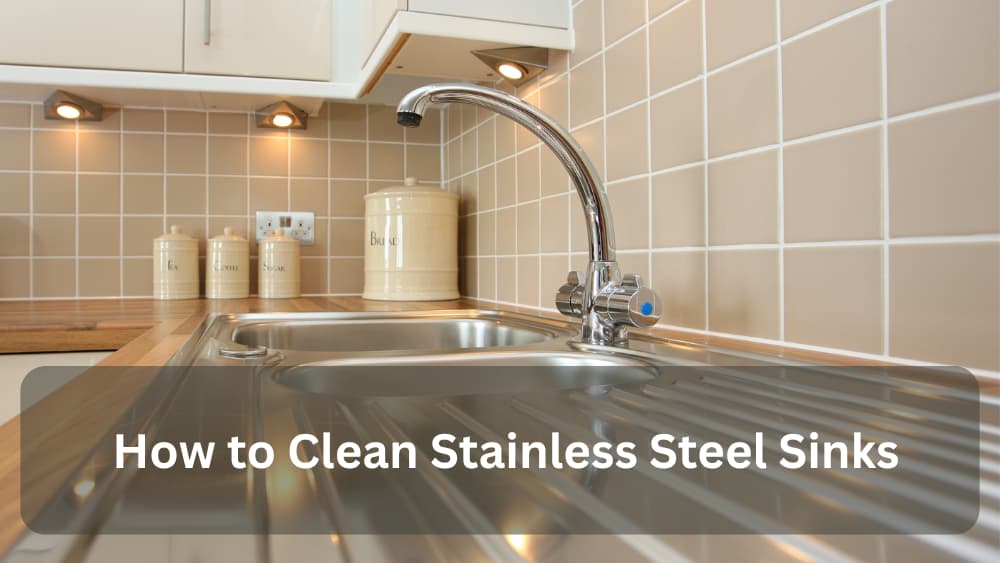Stainless steel sinks are among the most popular choices in kitchens worldwide. They’re durable, stylish, and resistant to rust and staining — but they’re not immune to everyday mess. Hard water spots, soap scum, greasy films, food residue, and even rainbow-like heat tints can leave your sink looking dull instead of gleaming.
The good news is that with the right cleaning approach, you can restore that signature shine without scratching or damaging the surface. This guide will show you how to clean stainless steel sinks daily, weekly, and deeply, plus how to handle stubborn marks and keep your sink looking like new for years.
Key Takeaways
- Rinse and wipe your sink daily to prevent buildup.
- Always clean with the grain of the steel to avoid swirl marks.
- Use mild soap, baking soda paste, and diluted vinegar for most stains.
- Avoid bleach, steel wool, and abrasive powders — they damage the protective finish.
- Finish every clean by drying and buffing with a microfiber cloth for a streak-free shine.
Why Do Stainless Steel Sinks Lose Their Shine?
Despite its name, stainless steel can show plenty of stains. The material resists rust thanks to its chromium oxide protective layer, but surface contaminants can still dull or discolor it. Common culprits include:
- Hard water spots: Minerals like calcium and magnesium leave chalky residue.
- Soap film and grease: Residue builds up over time, leaving a cloudy appearance.
- Metal transfer marks: Pots, pans, and utensils can leave gray or dark streaks.
- Heat tint: Very hot pans can create rainbow-like discoloration.
- Improper cleaning: Using steel wool or harsh chemicals can scratch or etch the surface.
Understanding the cause helps you pick the right cleaning method.
The Best Daily Cleaning Routine
The simplest way to keep a stainless steel sink spotless is to clean as you go.
Steps:
- Rinse with hot water after each use to remove food and soap residue.
- Apply a drop of dish soap to a soft sponge or cloth and wipe the basin, corners, and faucet base.
- Rinse thoroughly with warm water.
- Dry completely with a clean microfiber towel, following the grain.
This 2-minute routine prevents buildup and water spots, so you don’t need harsh scrubbing later.
Weekly Deep Clean
Even with daily care, your sink deserves a deeper clean once a week.
Step 1: Degrease
- Apply a small amount of dish soap to a soft sponge.
- Scrub the sink thoroughly, moving with the grain.
- Rinse with hot water.
Step 2: Remove Hard-Water Spots
- Mix equal parts white vinegar and water in a spray bottle.
- Mist lightly over the sink surface.
- Let it sit for 2–3 minutes.
- Wipe with a soft cloth and rinse.
(If you have marble or stone countertops, avoid vinegar near the edges — it can etch natural stone.)
Step 3: Tackle Residue and Scuffs
- Sprinkle baking soda evenly across the damp sink.
- Scrub gently with a sponge or nylon brush.
- Baking soda lifts stains without scratching.
- Rinse and dry completely.
Step 4: Buff for Shine
- Dampen a microfiber cloth with 70% isopropyl alcohol or a stainless steel cleaner.
- Buff in the direction of the grain.
- This removes streaks and fingerprints, leaving a uniform finish.
Removing Specific Stains
Hard Water Spots
- Use vinegar-water spray (1:1).
- Rinse thoroughly and dry to prevent new deposits.
Metal Marks from Pots and Pans
- Dab a baking soda paste (baking soda + a little water) onto the mark.
- Gently rub with a soft cloth, following the grain.
- Rinse and dry.
Heat Tint (Rainbow Discoloration)
- First clean with soap and water.
- Then use a damp cloth with a non-abrasive oxalic acid gel cleanser (like Bar Keeper’s Friend Soft Cleanser).
- Rub gently with the grain until the tint fades.
- Rinse thoroughly.
Stubborn Grease Film
- Mix a few drops of dish soap in hot water.
- Wipe the sink with a sponge soaked in the solution.
- For extra shine, wipe afterward with isopropyl alcohol.
What Not to Use on Stainless Steel Sinks
- Steel wool or wire brushes → cause scratches that trap dirt and rust.
- Abrasive powders → leave swirl marks and dull the finish.
- Bleach or chlorine cleaners → corrode stainless steel and ruin the protective layer.
- Oven cleaners or harsh chemicals → discolor and damage the sink.
Stick to gentle, non-abrasive tools and cleaners.
Caring for Sink Accessories
Your sink’s shine isn’t complete unless the accessories match.
Drain Ring and Strainer
- Wash with dish soap and a sponge.
- For mineral deposits, soak in diluted vinegar, rinse well, and dry.
Faucet Base
- Wrap a vinegar-soaked paper towel around the base for 5 minutes to dissolve crust.
- Rinse and wipe dry.
(Avoid vinegar on stone countertops.)
Bottom Grids and Racks
- Wash weekly in hot soapy water.
- Rinse thoroughly to prevent mineral spots.
Preventing Odors in the Drain
A clean sink can still smell bad if the drain isn’t maintained.
- Boiling water flush: Pour a kettle of boiling water down the drain once a week.
- Baking soda refresh: Add ½ cup baking soda, wait 5 minutes, flush with hot water.
- Garbage disposal care (if applicable): Scrub the splash guard with a brush and soapy water, run ice cubes and coarse salt for 15 seconds, then rinse with cold water.
This removes grease film and biofilm that cause odors.
Pro Tips to Keep Stainless Steel Sinks Looking New
- Always wipe with the grain, not in circles.
- Use a silicone sink mat to protect against scratches and heavy pots.
- Don’t let acidic foods (tomato sauce, lemon juice) sit in the sink for long periods.
- Rinse immediately after working with salty water — salt can corrode over time.
- Dry after every use — most spots form as water evaporates.
Sample Cleaning Schedule
| Task | Frequency | Tools/Products |
|---|---|---|
| Rinse and dry | Daily | Hot water, microfiber cloth |
| Soap wash | Daily | Dish soap, soft sponge |
| Baking soda scrub | Weekly | Baking soda paste, nylon brush |
| Vinegar spot treatment | Weekly/as needed | 1:1 vinegar-water spray |
| Stainless polish | Weekly | Alcohol wipe or stainless polish |
| Drain flush | Weekly | Boiling water, baking soda |
| Accessory clean (strainer, racks) | Weekly | Dish soap, sponge |
FAQs
Can I use lemon juice to clean stainless steel?
No — lemon is acidic and can dull or etch stainless over time. Stick to vinegar (controlled use) or baking soda.
Why does my sink still look streaky after cleaning?
You may be wiping against the grain or letting water air-dry. Always buff with a microfiber towel along the grain.
Do stainless steel sinks need polishing?
Not daily, but polishing weekly with alcohol or a stainless cleaner enhances shine and prevents fingerprints.
Is it safe to sanitize with bleach?
Avoid bleach — it can corrode stainless. Instead, sanitize with 70% isopropyl alcohol or hot soapy water.
Final Thoughts
Stainless steel sinks aren’t hard to maintain — they just need the right routine. By rinsing and drying daily, scrubbing weekly with baking soda, and tackling spots with vinegar or oxalic gel, you’ll keep your sink spotless without scratches.
Remember: less is more. Skip the harsh chemicals, stay with gentle cleaners, and always finish with a buff in the direction of the grain. With consistent care, your stainless steel sink will keep its modern shine for decades.

As the chief content writer, Hassan Al Sarker works as a professional kitchen-based content creator at Kitchen Liker.
In addition to reviewing the content published on Kitchen Liker, he ensures that it is accurate, relevant, and helpful. As a result, all the reviews and information published at Kitchen Liker are neutral and userfriendly.
Hassan Al Sarker has a bachelor’s degree in Hotel and Tourism Management From the Newyork University. Before joining Kitchen Liker, he was a contributor at Kitchen Club, United States.

